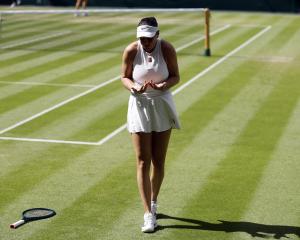It's back to reality after a whirlwind two weeks with the Maori All Blacks, and the last game against Japan was a close one.
It was a clash of two cultures, on and off the field. I got a glimpse of the intensity and focus of the Japan team's environment when I administered a survey to the team - you could have cut the air with a knife.
This intensity was such a huge contrast to the Maori team's environment.
This reeks of generalisations, but the Maori team room couldn't have been more different, with a laid back and less structured atmosphere.
The Maori players enjoy having a laugh but also know when to switch on and focus.
Trainings are intense and there is underlying structure but spontaneity and creativity are also encouraged.
The two approaches to the game/business of rugby came to a head on Saturday in Tokyo.
The Japanese crowd don't like to sing the national anthem with any vigour because of its association with war and a call to arms.
The few Kiwis in the crowd were singing at the top of their lungs even if they were slightly off key.
The haka is also a very important part of being in the Maori team and combines unity and form with the opportunity for individuals to express themselves.
The Japan team have no equivalent response but earlier in the week we were privy to Japan's version of a ''cheerleader'', who is employed to uplift the crowd.
A lone figure dressed in a black uniform performed very structured and rigid movements while yelling at the top of their lungs and the crowd repeat the chant ''Nippon'' as and when prompted.
As a sociologist, I love these contrasts in cultural rituals and the values and attitudes associated with them.
The Japanese team in Tokyo was also a very different team to the one that was beaten 61-21 in Kobe. Under firmer soil, in front of a more rugby savvy and international audience, and with Eddie Jones' stern words ringing in their ears, they came to redeem themselves and Japan.
Their set pieces were outstanding, their grass-cutting tackling style worked well in the damp conditions, and their attacking phases were more threatening.
Perhaps the formality, structure and hours of training would triumph over a more relaxed approach on this occasion?
In contrast, the Maori team struggled to get any possession, and when it did get a sniff of the ball, it seemed to kick it away.
Two of the newer members of the team, Nehe Milner-Skudder and Codie Taylor, scored some great tries which suggested the boys in black might run away with this game in the second half, but Japan had other ideas.
With about 5 minutes to go, I had thrown any decorum I had out with my leftover sushi lunch and I was yelling and jumping up and down and wishing for the Maori All Blacks to unleash some of their magic.
Sure enough, that is exactly what was delivered.
Jamison Gibson-Park threw in a quick lineout that travelled half the width of the field and the Maori team had an overlap out wide as Japan scurried to cover defend.
Charlie Ngatai attacked the line with determination and looked like he was about to destroy any try-scoring opportunity by holding on to the ball for too long when he unleashed one of those one-handed flick passes Sonny Bill Williams has mastered.
Dan Pryor, who had over-run Charlie by this stage, managed to catch the ball behind him and scored the winning try in a flurry of dreadlocks to put the Maori All Blacks in the lead by two points.
Could I ever see the Japanese team putting all that together without practising it? I doubt it. It was heart-in-your-mouth stuff and it still wasn't over.
With less than a few minutes left, we had the ball again and anyone thinking reasonably would suggest this was a time to hold on to the ball and play out the clock.
But this is the Maori All Blacks and taking risks and being flamboyant is often synonymous with Maori rugby. Someone decided it was time to kick possession away again and Japan had one last chance to attack.
After several phases and due to luck rather than anything else, Japan lost possession and we kicked the ball out to end of the game.
So what do the Maori All Blacks and the All Blacks have in common other than their name and the black jersey?Both teams are able to maintain their composure under pressure and know how to squeeze out a win in the dying minutes of a game despite being outscored or dominated in some cases for most of the game.
Is that due to the development programmes and structures of New Zealand rugby or is it a cultural thing? Or is it a combination of refereeing decisions and luck?I'd say it's a combination of all of the above. Sport is a great place for cultures to express themselves, and rugby is no exception.
Sayonara Japan and kia ora New Zealand. It's good to be home.












